#princess adelaide of saxe meiningen
Text


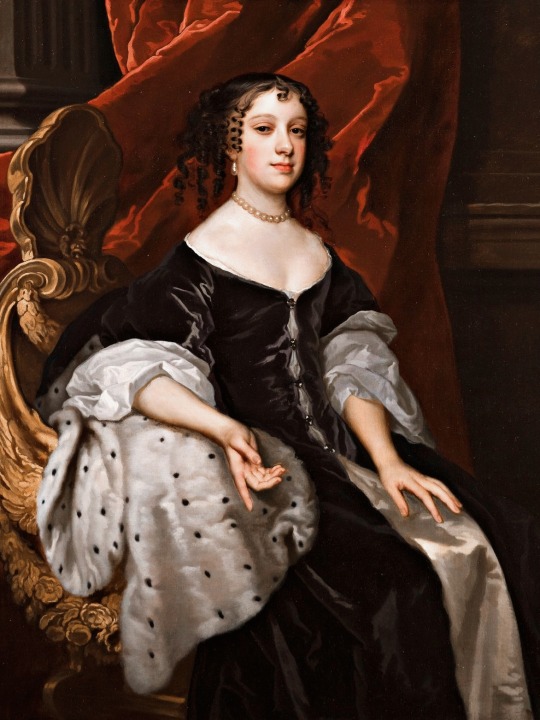
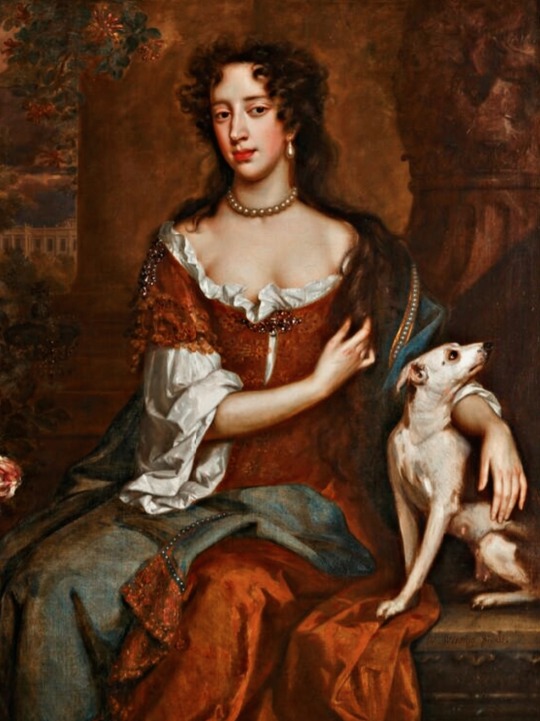


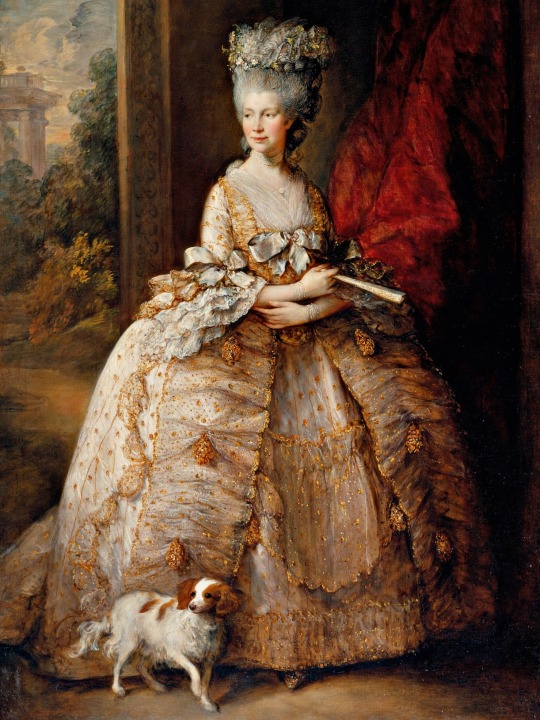
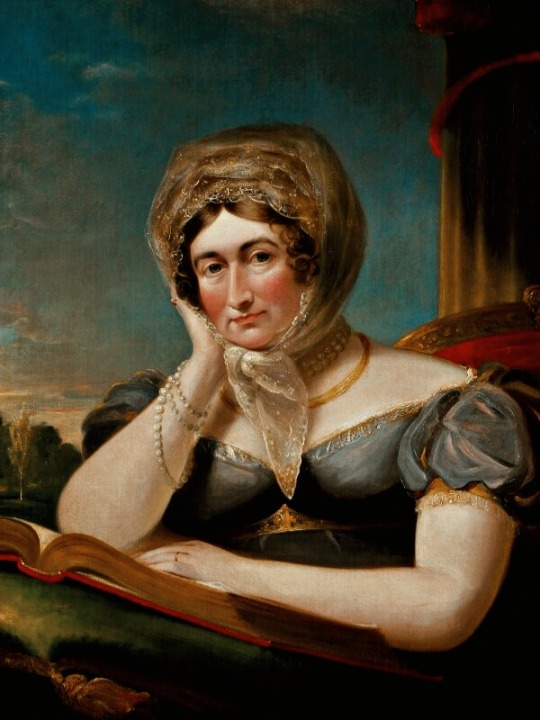
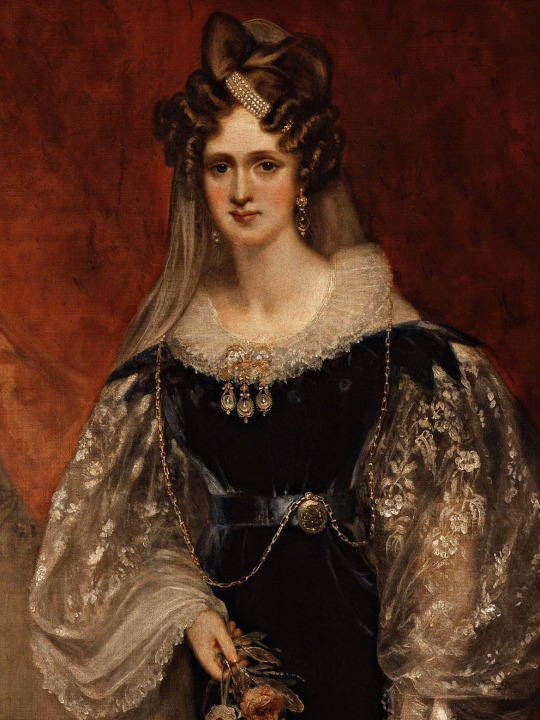
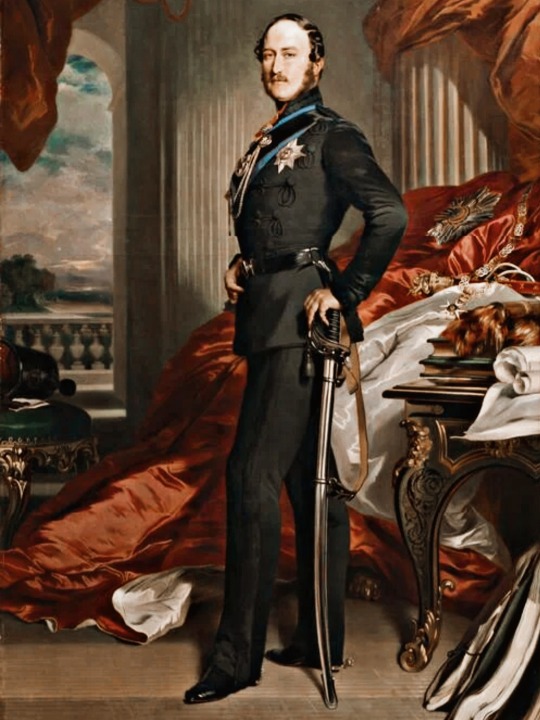
CONSORTS OF ENGLAND SINCE THE NORMAN INVASION (4/5) ♚
Anne of Denmark (March 1603 - March 1619)
Henrietta Maria of France (June 1625 - January 1649)
Catherine of Braganza (May 1662 - February 1685)
Mary of Modena (February 1685 - December 1688)
Prince George of Denmark (March 1702 - October 1708)
Princess Caroline of Brandenburg-Ansbach (June 1727 - November 1737)
Princess Charlotte of Mecklenburg-Strelitz (September 1761 - November 1818)
Princess Caroline of Brunswick-Wolfenbüttel (January 1820 - August 1821)
Princess Adelaide of Saxe-Meiningen (June 1830 - June 1837)
Prince Albert of Saxe-Coburg and Gotha (February 1840 - December 1861)
#historyedit#history#consorts of england and britiain.#my photoset.#historical royals#anne of denmark#henrietta maria#henrietta maria of france#catherine of braganza#mary of modena#george of denmark#princess caroline of brandenburg ansbach#queen charlotte#princess charlotte of Mecklenburg strelitz#princess caroline of brunswick wolfenbüttel#princess adelaide of saxe meiningen#english history#history edit#queen consort#prince consort#prince albert#queen victoria#victoria and albert#young victoria#british royals#royals#royal#queen adelaide#queen anne#queen mary
62 notes
·
View notes
Text

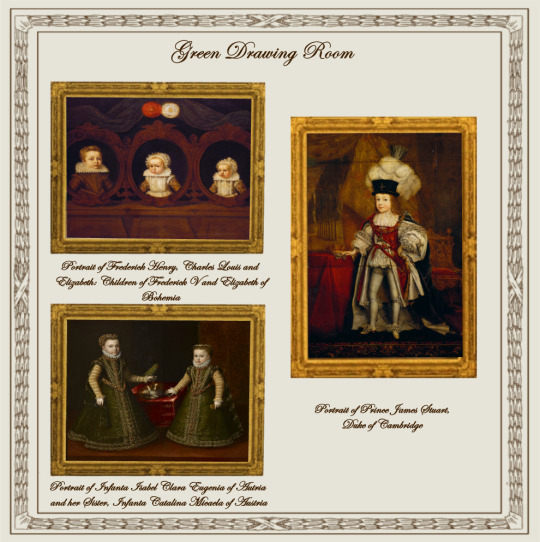
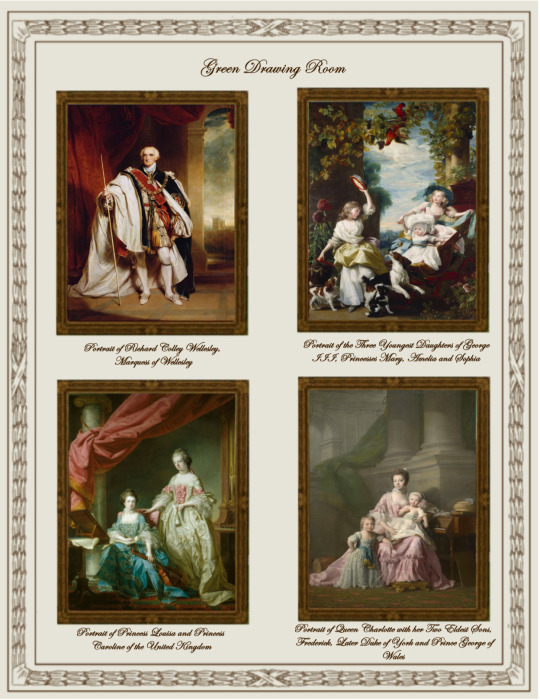
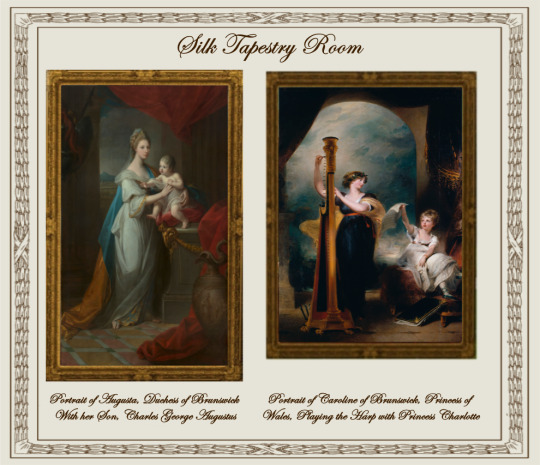
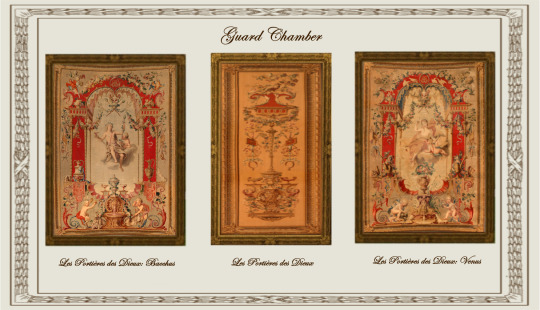

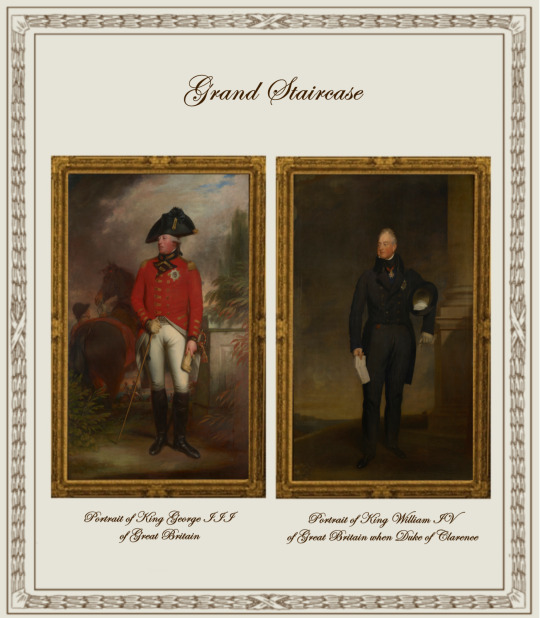
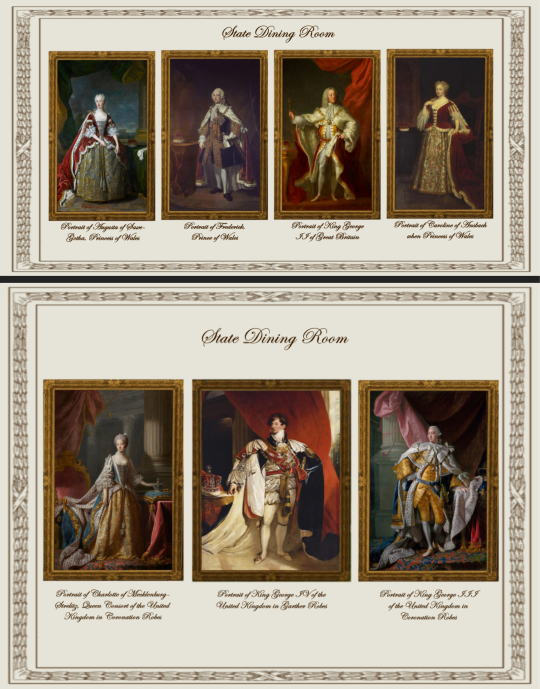
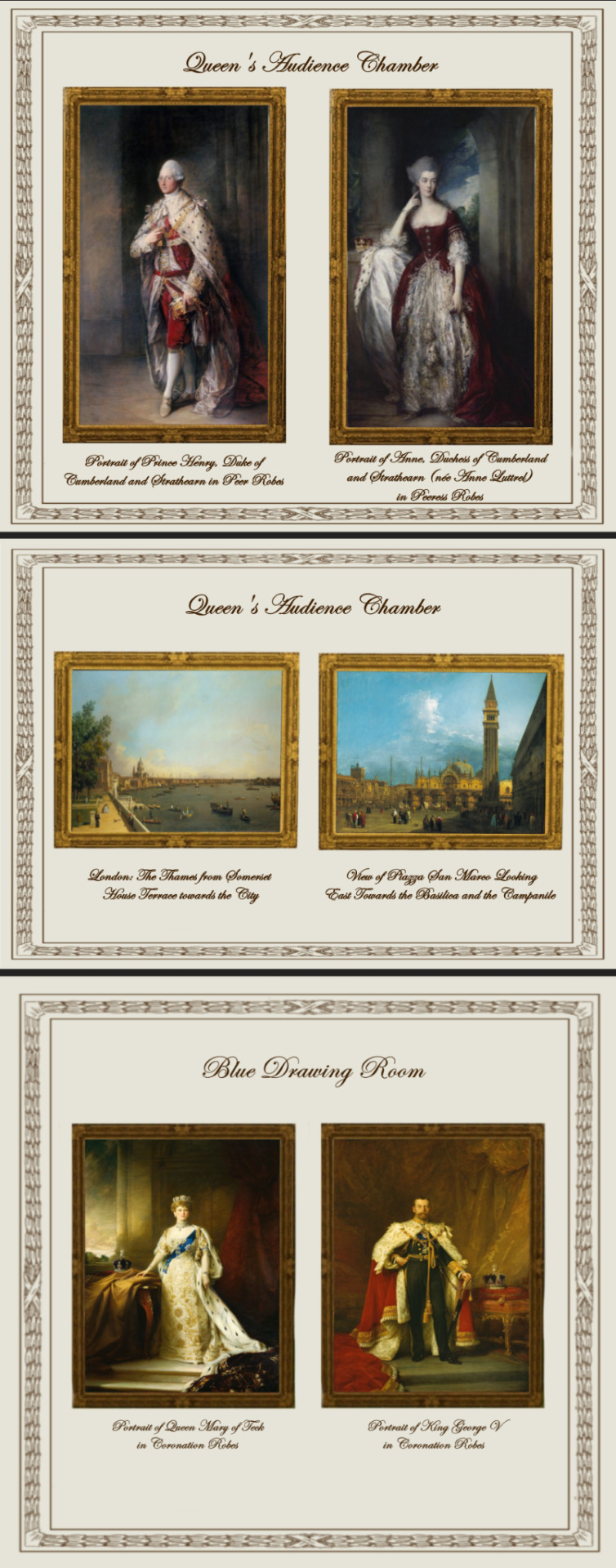
Paintings from Buckingham Palace: part I
A retexture by La Comtesse Zouboff — Original Mesh by @thejim07
100 followers gift!
First of all, I would like to thank you all for this amazing year! It's been a pleasure meeting you all and I'm beyond thankful for your support.
Spread among 13 occupied and historic royal residences in the United Kingdom, the collection is owned by King Charles III and overseen by the Royal Collection Trust. The British monarch owns some of the collection in right of the Crown and some as a private individual. It is made up of over one million objects, including 7,000 paintings, over 150,000 works on paper, this including 30,000 watercolours and drawings, and about 450,000 photographs, as well as around 700,000 works of art, including tapestries, furniture, ceramics, textiles, carriages, weapons, armour, jewellery, clocks, musical instruments, tableware, plants, manuscripts, books, and sculptures.
Some of the buildings which house the collection, such as Hampton Court Palace, are open to the public and not lived in by the Royal Family, whilst others, such as Windsor Castle, Kensington Palace and the most remarkable of them, Buckingham Palace are both residences and open to the public.
About 3,000 objects are on loan to museums throughout the world, and many others are lent on a temporary basis to exhibitions.
-------------------------------------------------------
This first part includes the paintings displayed in the White Drawing Room, the Green Drawing Room, the Silk Tapestry Room, the Guard Chamber, the Grand Staircase, the State Dining Room, the Queen's Audience Room and the Blue Drawing Room,
This set contains 37 paintings and tapestries with the original frame swatches, fully recolourable. They are:
White Drawing Room (WDR):
Portrait of François Salignan de la Mothe-Fénelon, Archbishop of Cambrai (Joseph Vivien)
Portrait of a Lady (Sir Peter Lely)
Portrait of a Man in Armour with a red scarf (Anthony van Dyck)
Portrait of Alexandra of Denmark, Queen Consort of the United Kingdom and Empress of India (François Flameng)
Green Drawing Room (GDR):
Portrait of Prince James Stuart, Duke of Cambridge (John Michael Wright)
Portrait of Frederick Henry, Charles Louis and Elizabeth: Children of Frederick V and Elizabeth of Bohemia (unknown)
Portrait of Infanta Isabel Clara Eugenia of Autria and her Sister, Infanta Catalina Micaela of Austria (Alonso Sanchez Coello)
Portrait of Princess Louisa and Princess Caroline of the United Kingdom (Francis Cotes)
Portrait of Queen Charlotte with her Two Eldest Sons, Frederick, Later Duke of York and Prince George of Wales (Allan Ramsay)
Portrait of Richard Colley Wellesley, Marquess of Wellesley (Martin Archer Shee)
Portrait of the Three Youngest Daughters of George III, Princesses Mary, Amelia and Sophia (John Singleton Copley)
Silk Tapestry Room (STR):
Portrait of Caroline of Brunswick, Princess of Wales, Playing the Harp with Princess Charlotte (Sir Thomas Lawrence)
Portrait of Augusta, Duchess of Brunswick With her Son, Charles George Augustus (Angelica Kauffmann)
Guard Chamber (GC):
Les Portières des Dieux: Bacchus (Manufacture Royale des Gobelins)
Les Portières des Dieux: Venus (Manufacture Royale des Gobelins)
Les Portières des Dieux (Manufacture Royale des Gobelins)
Grand Staircarse (GS):
Portrait of Adelaide of Saxe-Meiningen, Queen Consort of Great Britain (Martin Archer Shee)
Portrait of Augustus, Duke of Sussex (Sir David Wilkie)
Portrait of Edward, Duke of Kent (George Dawe)
Portrait of King George III of Great Britain (Sir William Beechey)
Portrait of King William IV of Great Britain when Duke of Clarence (Sir Thomas Lawrence)
Portrait of Leopold I, King of the Belgians (William Corden the Younger)
Portrait of Prince George of Cumberland, Later King George V of Hanover When a Boy (Sir Thomas Lawrence)
Portrait of Princess Charlotte Augusta of Wales (George Dawe)
Portrait of Queen Charlotte at Frogmore House (Sir William Beechey)
Portrait of Victoria of Saxe-Coburg-Saafeld, Duchess of Kent (Sir George Hayter)
State Dining Room (SDR):
Portrait of Charlotte of Mecklenburg-Strelitz, Queen Consort of the United Kingdom in Coronation Robes (Allan Ramsay)
Portrait of King George III of the United Kingdom in Coronation Robes (Allan Ramsay)
Portrait of Augusta of Saxe-Gotha, Princess of Wales (Jean-Baptiste Van Loo)
Portrait of Caroline of Ansbach when Princess of Wales (Sir Godfrey Kneller)
Portrait of Frederick, Princes of Wales (Jean-Baptiste Van Loo)
Portrait of King George II of Great Britain (John Shackleton)
Portrait of King George IV of the United Kingdom in Garther Robes (Sir Thomas Lawrence)
Queen's Audience Room (QAR):
Portrait of Anne, Duchess of Cumberland and Strathearn (née Anne Luttrel) in Peeress Robes (Sir Thomas Gainsborough)
Portrait of Prince Henry, Duke of Cumberland and Strathearn in Peer Robes (Sir Thomas Gainsborough)
London: The Thames from Somerset House Terrace towards the City (Giovanni Antonio Canal "Canaletto")
View of Piazza San Marco Looking East Towards the Basilica and the Campanile (Giovanni Antonio Canal "Canaletto")
Blue Drawing Room (BDR)
Portrait of King George V in Coronation Robes (Sir Samuel Luke Fildes)
Portrait of Queen Mary of Teck in Coronation Robes (Sir William Samuel Henry Llewellyn)
-------------------------------------------------------
Found under decor > paintings for:
500§ (WDR: 1,2 & 3)
1850§ (GDR: 1)
1960§ (GDR: 2 & 3 |QAR 3 & 4)
3040§ (STR, 1 |GC: 1 & 2|SDR: 1 & 2)
3050§ (GC:1 |GS: all 10|WDR: 4 |SDR: 3,4,5 & 6)
3560§ (QAR: 1 & 2|STR: 2)
3900§ (SDR: 7| BDR: 1 & 2|GDR: 4,5,6 & 7)
Retextured from:
"Saint Mary Magdalene" (WDR: 1,2 & 3) found here .
"The virgin of the Rosary" (GDR: 1) found here .
"The Four Cardinal Virtues" (GDR: 2&3|QAR 3 & 4) found here.
"Mariana of Austria in Prayer" (STR, 1, GC: 1 & 2|SDR: 1 & 2) found here.
"Portrait of Philip IV with a lion at his feet" (GC:1 |GS: all 10|WDR: 4 |SDR: 3,4,5 & 6) found here
"Length Portrait of Mrs.D" (QAR: 1 & 2|STR: 2) found here
"Portrait of Maria Theresa of Austria and her Son, le Grand Dauphin" (SDR: 7| BDR: 1 & 2|GDR: 4,5,6 & 7) found here
(you can just search for "Buckingham Palace" using the catalog search mod to find the entire set much easier!)

Drive
(Sims3pack | Package)
(Useful tags below)
@joojconverts @ts3history @ts3historicalccfinds @deniisu-sims @katsujiiccfinds @gifappels-stuff
-------------------------------------------------------
#the sims 3#ts3#s3cc#sims 3#sims 3 cc#sims 3 download#sims 3 decor#edwardian#rococo#baroque#renaissance#buckingham#buckingham palace#royal collection trust#wall decor
94 notes
·
View notes
Text
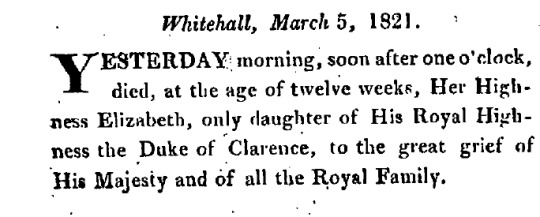

On this day in history, March 4th, in 1821, Princess Elizabeth of Clarence died of an intro-susception of the bowels. She was a little over two months old, and was the daughter of the future William IV and Adelaide of Saxe-Meiningen.
She had been born prematurely, and was quickly baptized the day of her birth. She was christened Elizabeth Georgina Adelaide, with the initial choice of her parents being the name Georgina. Her uncle, George IV, wanted her to be called Elizabeth instead so Georgina would become her second name.
Her parents had already suffered the loss another daughter, Charlotte, who died on the day of her birth, and a miscarriage. Two years after Elizabeth’s death, Adelaide gave birth to stillborn twin boys, and possibly had another miscarriage that same year. Ultimately, they had no surviving children and when William died, the throne passed to his niece, Queen Victoria.
#william IV#adelaide of saxe-meiningen#elizabeth of clarence#house of hanover#british royal family#george iv#long live the queue
31 notes
·
View notes
Text
Breaking news - Cambridges to move to Adelaide Cottage
Kate and William, along with their three children, are moving to Adelaide Cottage located in Windsor Home Park. It is just a short walk from the Queen at Windsor Castle. This comes amid mounting concerns over the Queen's health.
The newspaper location image is incorrect. I have posted satellite images of the actual correct location and a zoom shot to identify the house.

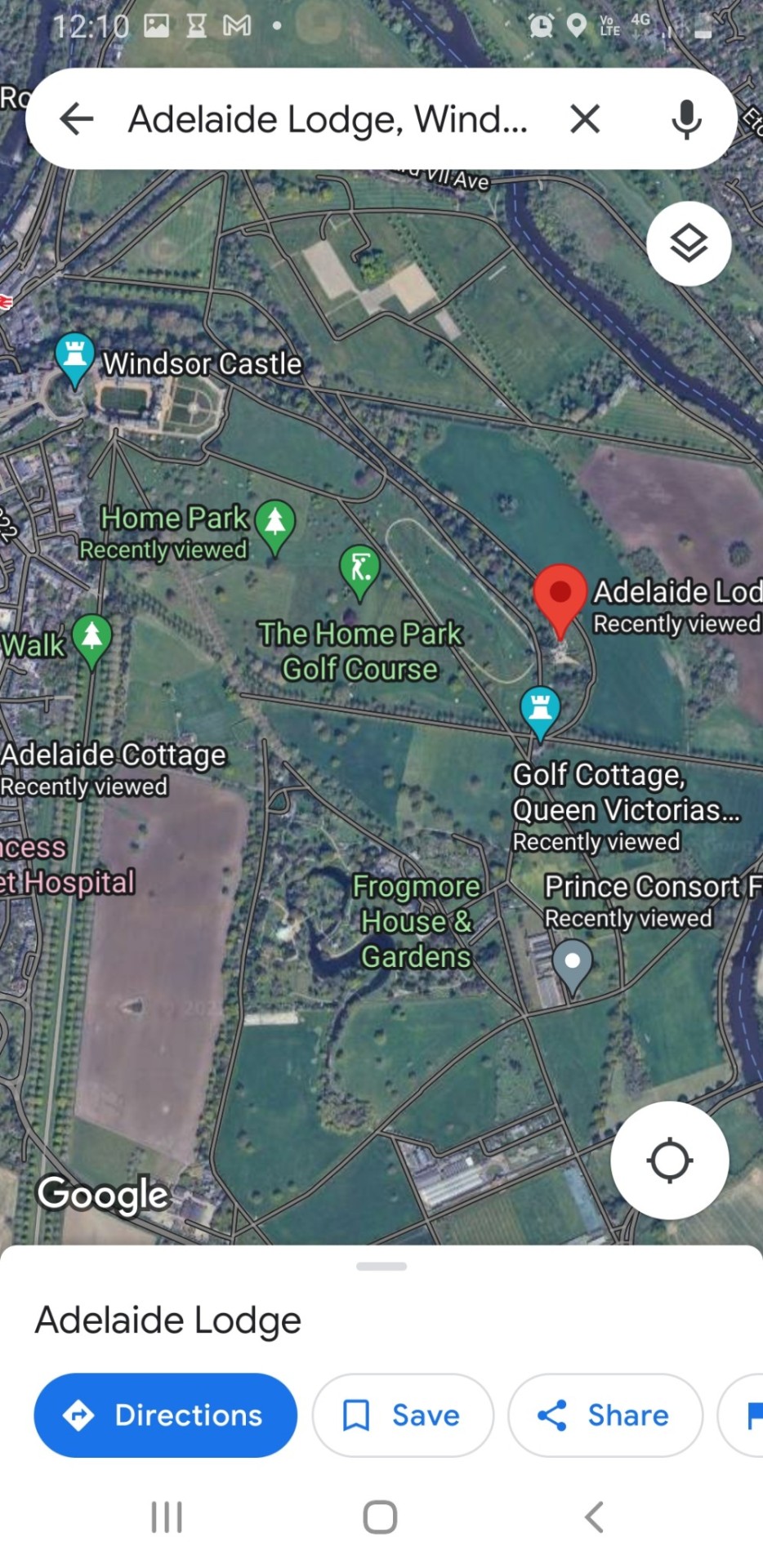
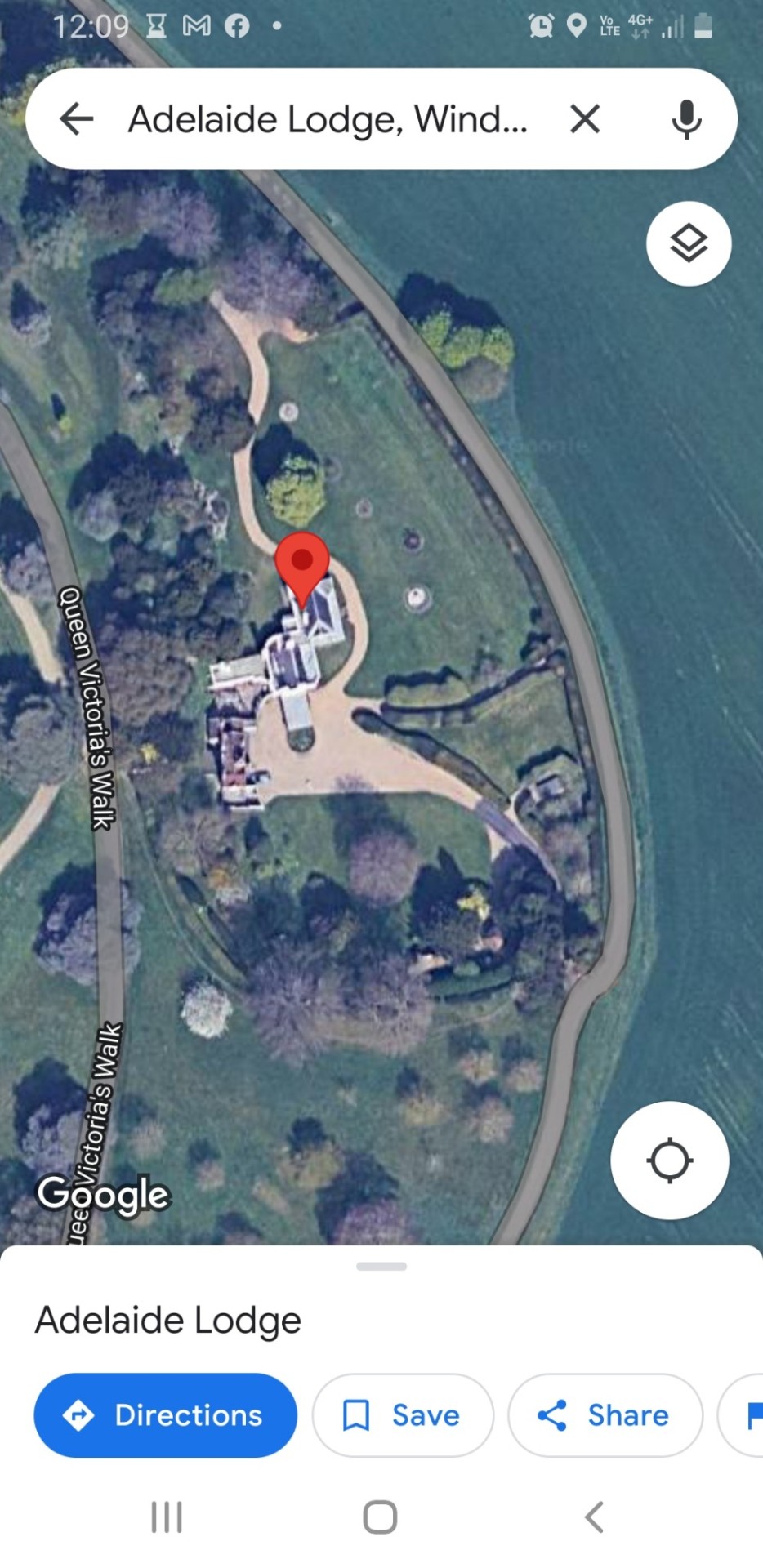

Prince William and Kate’s new home has been revealed as royals move to be nearer the Queen.
She is reportedly suffering from "episodic mobility problems" and has been forced to miss a number of public engagements in recent months.
The 96-year-old monarch missed the State Opening of Parliament in early May and missed the Easter Sunday Service at St George's Chapel the month before.
More recently, she chose to take a backseat during June's Platinum Jubilee celebrations.
She has also been pictured using a walking stick at most events.

The Cambridges are reportedly hoping to move into Adelaide Cottage this summer.
This would mean that George, eight, Charlotte, seven, and four-year-old Louis can start school in the local area in September.
The home reportedly needs no costly renovations.
According to the Sun, they will also have no live-in staff, with aides commuting to the residence.
A source told the paper that they are looking forward to "starting a new chapter in their lives together".
They said: "Kate and William were very keen for a modest home to start their new lives in Windsor.

"Adelaide Cottage fits the bill because it is a four-bedroom home and they do not need any more as they have no live-in staff.
"They were adamant they didn’t want anything too showy or anything that needed renovating or extra security so as not to be a burden on the taxpayer.
"They will pay rent from their private account.
"All they need to do is move in some of their treasured furniture and possessions.
"The whole family is looking forward to moving in this summer and starting a new chapter in their lives together in Windsor."
Nestled at the heart of the Crown Estate’s private 655-acre royal park, Adelaide Cottage was built in 1831 as a retreat for William IV’s wife Queen Adelaide of Saxe-Meiningen.
It was also known to be a favourite home of Queen Victoria, as she frequently enjoyed taking her breakfast there.
However, the most famous former resident has to be the late Princess Margaret’s ex-beau, Group Captain Peter Townsend, whose affair with the Queen’s sister caused a national scandal.
The cottage underwent major renovations in 2015, which means the Cambridges would not have to shell out millions in remodelling the house.
Adelaide Cottage still boasts original features including a marble Graeco-Egyptian fireplace and a principal bedroom with a coved ceiling featuring gilded dolphins and rope ornament reused from the Royal yacht Royal George.
It also has seven gated entrances and exits to Windsor Castle so the family can come and go in relative privacy.

Full story here
https://www.express.co.uk/news/royal/1624984/Kate-middleton-prince-william-queen-elizabeth-ii-adelaide-cottage-windsor-latest
and here
https://viacasinos.com/entertainment/prince-william-and-kate-are-set-to-move-their-family-into-four-bedroom-on-the-windsor-estate/
14 notes
·
View notes
Text
Which British king died in 1837?

The death of King William IV on 20th June 1837 saw the 18-year-old Princess Victoria inherit the throne of the United Kingdom of Great Britain and Ireland. William Henry was the king from 26th June 1830, after succeeding his elder brother, George IV. He was 64 years old.
William IV did not engage much in politics during his reign, but he did see slavery abolished in nearly all of the British Empire. Although William married Princess Adelaide of Saxe-Meiningen, he had no surviving legitimate children by the time of his death. The eight surviving illegitimate children he had by the actress Dorothea Jordan had no right to the throne, so he was succeeded by his niece, Victoria. Her father's three elder brothers died without leaving any legitimate children.
Victoria was queen for 63 years, seven months longer than any other king or queen of Britain until Queen Elizabeth II. People called her the 'grandmother of Europe' because many of Victoria's children became kings, princes and princesses of other countries. After she died from a brain haemorrhage in 1901, her son Edward VII became King of the United Kingdom until his death on 6th May 1910.
2 notes
·
View notes
Text

Prince and Princess Friedrich of Saxe-Meiningen with their chidren in 1904.
#prince friedrich of saxe-meiningen#princess friedrich of saxe-meiningen#princess feodora karola of saxe-meiningen#princess adelaide of saxe-meiningen#prince georg of saxe-meiningen#prince ernst leopold of saxe-meiningen#princess luise marie of saxe-meiningen#prince bernhard of saxe-meiningen#saxe-meiningen#german royalty#german royal#1904#1900s
17 notes
·
View notes
Photo

Prince Adalbert of Prussia and his wife, Adelaide of Saxe-Meiningen, 1917.
#Prince Adalbert of Prussia#Princess Adelaide of Saxe-Meiningen#prussian royal family#1910s#postcard#rrppc
11 notes
·
View notes
Photo

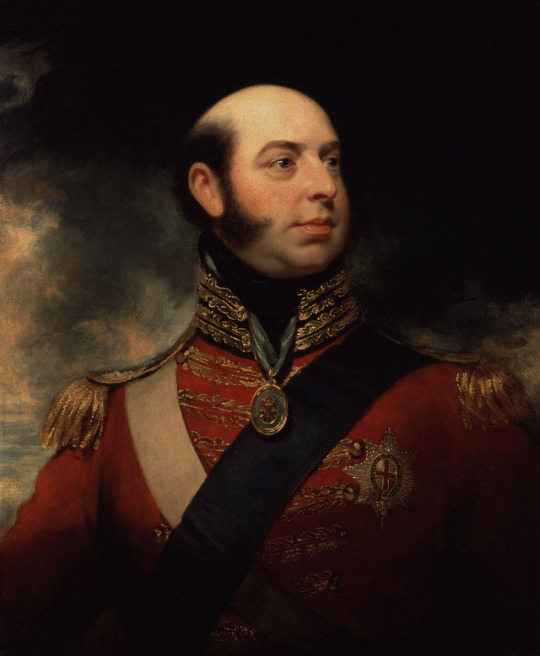
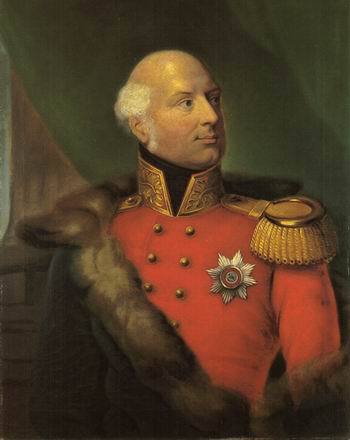


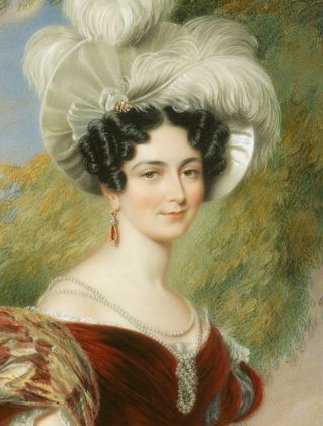
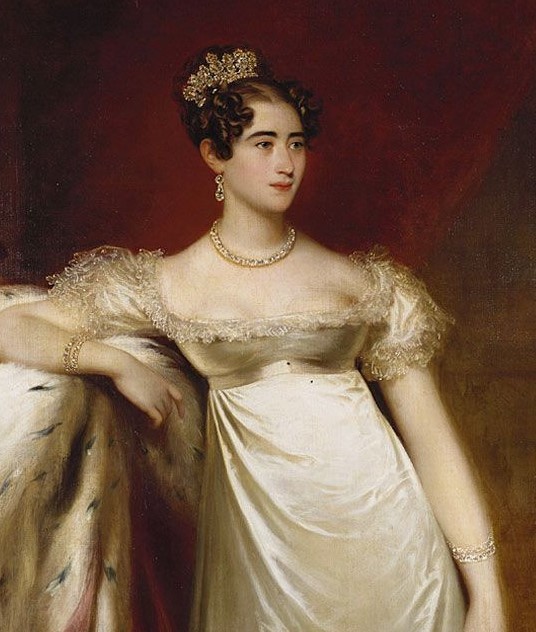
Princess Charlotte of Wales’ Death and the Subsequent Race Among George III’s Sons for a Wife to Provide Heirs to the Throne
Charlotte was the daughter of the Prince Regent - the future George IV. She was the prince’s only legitimate offspring, and she would one day be Queen of England...
Charlotte...possessed the advantage not merely of being young, intelligent and beautiful; she was also the daughter of a highly unpopular Prince Regent and niece of his even less attractive brothers. Charlotte was the nation’s bright future, the figure in whom the British people could rest their hopes.
Princess Charlotte suffered two miscarriages, but in 1817, she appeared to be carrying a baby to full term. This was indeed the case... It was to be an important national event; Charlotte was heir presumptive to the King George III’s throne...
At nine in the evening on 5 November, a son was stillborn... As evening turned to night, however, it was evident that all was not well. [Charlotte] was hemorrhaging internally... At 2:30am on 6 November 1817, Princess Charlotte died.
It was an event which caused intense national shock. George III was still alive, but the question of succession now posed itself insistently. In the immediate future, there was no danger of the line actually fizzling to nothing. Of his fifteen children, twelve survived; but the youngest of these, Princess Sophia was forty years old, and the only hope of breeding a new heir rested with the sons. The Prince Regent - destined to inherit the throne in 1820 - was out of the running; he was long estranged from his wife, Caroline of Brunswick. The Duke of York, whose German wife was immured in the English countryside, had no hope of a legitimate child. He was fifty-four years old, and deeply involved with a middle-aged mistress. The next in line, William, Duke of Clarence [the future William IV, had suffered no difficulty in producing children. He had ten of them, by the celebrated comedienne Mrs Jordan, but none were legitimate. The Duke of Kent, aged fifty, had been living a quasi-marital existence, very fondly, with his French-Canadian mistress Madame de Saint-Laurent for the last twenty-four years, and even if she were to be made his lawful wife, she was too old to have children. The Duke of Sussex had twice defied the Royal Marriages Act by taking wives without his father’s consent. Neither the Duke of Cumberland* nor the Duke of Cambridge, at the time of Charlotte’s death, had any legitimate successors.
The Princess’s death therefore triggered a race, among the overweight, late-middle-aged sons of George III, to find a lawful wife who could become the next Queen of England, and the mother of future monarchs. The Duke of Clarence ditched Mrs Jordan and made repeated proposals of marriage to a Ramsgate heiress named Miss Tilney Long. Having been repeatedly refused, he tried a woman in Brighton called Miss Wykeham, and when she turned him down he went down the traditional royal path of seeking a bride among the royal stud farms of Protestant Germany. He selected the plain, evangelical Princess Adelaide of Saxe-Meiningen, aged twenty-six. The Duke of Cambridge, aged a sprightly forty-three, joined the race by marrying Princess Augusta of Hesse-Cassel, a beautiful girl aged twenty who was a great-granddaughter of King George II of England...
While the portly dukes of Clarence and Cambridge were doing their bit for the advancement of the English monarchy by discarding their mistresses and pursuing brides of childbearing age, their brother the Duke of Kent was not to be outdone. Satirists did their best to make the situation funny, but it was one of those occasions, of which English history provides so many, when events were more grotesque than satire could ever invent.
“Yoicks! The R-1 Sport’s begun
I’faith but it is glorious fun
For hot and hard each R-1 pair
Are at it hunting for an heir”
“The country will now look up to me, Mr Creevey, to give them an heir to the crown,” he [Duke of Kent] said... Two possible brides came a once to mind: the Princess of Baden and the Princess of Saxe-Coburg.
The later was his choice... She was the sister of the widowed Prince Leopold... She was only seventeen when they married her to Prince Emich Charles of Leiningen, a man old enough to be her father... Two children were born to her... The marriage was not a happy one, and in 1814, Victoire was left a poverty stricken widow... Plump, red-cheeked, brightly dressed in silks and satins as she might have been, she was all but an indigent when she met the Duke of Kent in 1818. She had no prospects outside the chance of marriage. She was thirty-two years old.
The pair left Amorbach and went to her native Coburg to be married... Kent took his bride to England, and on 11 July, at Kew, they went through the marriage ceremony again, this time according to the rites of the Church of England. In the same ceremony, his brother William, Duke of Clarence, was married to Princess Adelaide of Saxe-Meiningen.
“Victoria: A Life,” A. N. Wilson
*The Duke of Cumberland [Ernest Augustus, the future King of Hanover] was already married at the time of Princess Charlotte of Wales’ death.
#princess charlotte of wales#george iii#william iv#edward duke of kent#historyedit#adelaide of saxe-meiningen#victoria of saxe-coburg-saalfeld#augusta of hesse-cassel#history#my edit#a. n. wilson#victoria: a life
107 notes
·
View notes
Photo
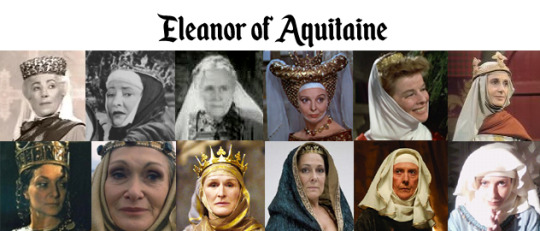





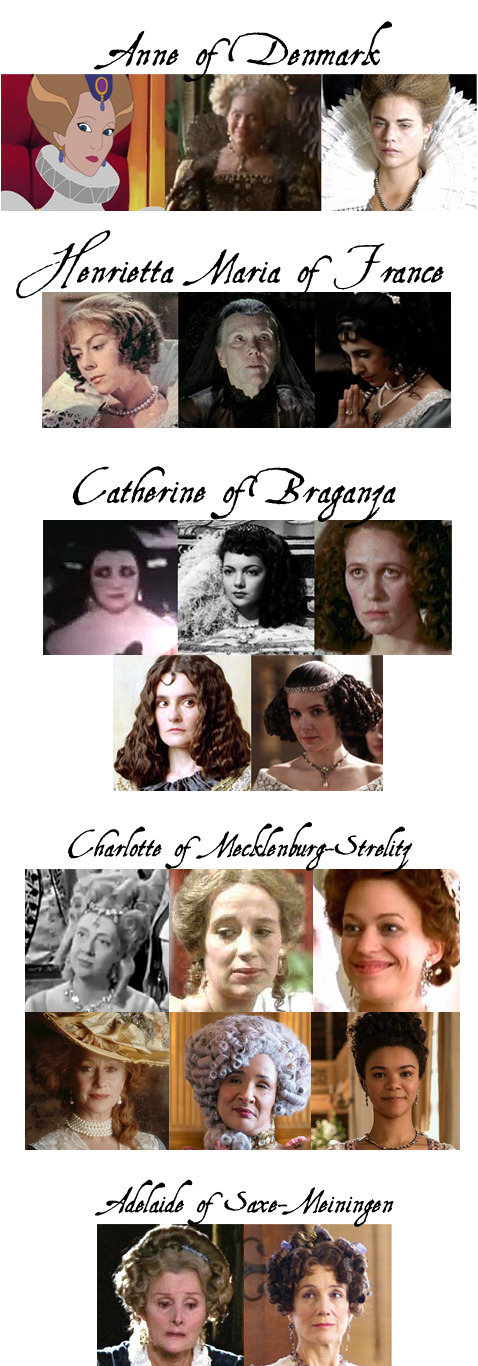
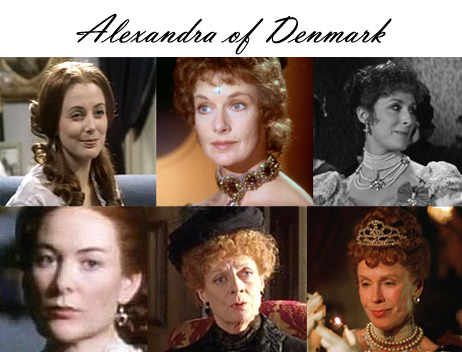
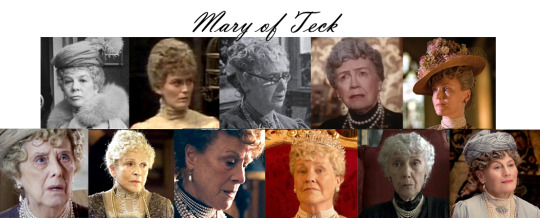

The Queen Consorts of England (minus Henry VIII’s wives) in Film and TV
(No appearances: Matilda of Flanders, Matilda of Scotland, Adeliza of Louvain, Matilda of Boulogne, Eleanor of Provence, Eleanor of Castile, Margaret of France, Anne of Bohemia, Joan of Navarre, Mary of Modena, Caroline of Ansbach, Caroline of Brunswick)
Henry’s wives
Eleanor of Aquitaine, Berengaria of Navarre, and Isabella of Angouleme:
The Devil’s Crown (1978)
Just Eleanor and Berengaria:
Richard the Lionheart (1962)
Just Eleanor and Isabella:
The Adventures of Robin Hood (1955)
Robin Hood (2010)
Robin and Marian (1976)
Just Eleanor:
The Story of Robin Hood and His Merrie Men (1952)
Ivanhoe (1958)
Becket (1964)
The Lion in Winter (1968)
The Legend of Robin Hood (1975)
Robin of Sherwood (1984)
Ivanhoe (1997)
The Lion in Winter (2003)
Robin Hood (2006)
Richard the Lionheart: Rebellion (2014)
Just Berengaria:
Richard the Lion-Hearted (1923)
The Crusades (1935)
King Richard and the Crusaders (1954)
Isabella of France and Philippa of Hainault:
Les rois maudits (1972)
A Cursed Monarchy (2005)
Just Isabella:
Edward II (1970)
Braveheart (1995)
World Without End (2012)
Knightfall (2017)
Isabella of Valois, Catherine of Valois, Margaret of Anjou, Elizabeth Woodville, and Anne Neville:
An Age of Kings (1960)
The Wars of the Roses (1965)
The Hollow Crown (2016)
Just Margaret, Elizabeth, and Anne:
Richard III (1912)
The Tragedy of Richard III (1989)
Just Elizabeth and Anne:
Tower of London (1939)
Richard III (1955)
Tower of London (1962)
Just Isabella
The Tragedy of King Richard II (1970)
King Richard the Second (1978)
Just Catherine:
Henry V (1944)
Henry V (1979)
Henry V (1989)
The King (2019)
Margaret, Elizabeth Woodville, Anne, and Elizabeth of York:
Richard III (1908)
The White Queen (2013)
Just Elizabeth Woodville and Elizabeth of York:
Jane Shore (1915)
Shadow of the Tower (1972)
The White Princess (2017)
The Real White Queen and Her Rivals (2017)
Just Elizabeth of York:
Princes in the Tower (2005)
The Spanish Princess (2019)
Anne of Denmark:
Pocahontas 2: Journey to a New World (1998)
Gunpowder, Treason, and Plot (2004)
The New World (2005)
Henrietta Maria of France:
Cromwell (1970)
The Devil’s Whore (2008)
Catherine of Braganza:
The Glorious Adventure (1922)
Forever Amber (1947)
England, My England (1995)
The Great Fire (2014)
Henrietta and Catherine:
Charles II: The Power & the Passion (2003)
Charlotte of Mecklenburg-Strelitz
The Young Mr. Pitt (1942)
Prince Regent (1979)
The Madness of King George (1994)
Longitude (2000)
Bridgerton (2020)
Queen Charlotte: A Bridgerton Story (2023)
Adelaide of Saxe-Meiningen:
Victoria & Albert (2001)
The Young Victoria (2009)
Alexandra of Denmark and Mary of Teck:
Edward VII (1975)
The Lost Prince (2003)
Just Alexandra:
Lillie (1978)
The Elephant Man (1980)
Mrs. Brown (1997)
All the King’s Men (1999)
Mary of Teck and Elizabeth Bowes-Lyon:
Crown Matrimonial (1974)
Bertie and Elizabeth (2002)
The King’s Speech (2010)
W.E. (2011)
The Crown (2016)
Just Mary:
Edward & Mrs. Simpson (1978)
The Woman He Loved (1988)
Wallis & Edward (2005)
Downton Abbey (2010)
Downton Abbey (2019)
Just Elizabeth:
The Queen (2006)
Hyde Park on Hudson (2012)
A Royal Night Out (2015)
#plantagenets#tudors#stuarts#hanoverians#victorians#windsors#Mary of Teck's numbers surprised me#There are a couple more shakespeare adaptations I didn't dig through properly#Queens on screens
237 notes
·
View notes
Photo

Princess Adelaide Erna Caroline Marie Elisabeth "Adi" of Saxe-Meiningen (1891 – 1971), later Princess Adalbert of Prussia, was a daughter of Prince Frederick John of Saxe-Meiningen and his wife Countess Adelaide of Lippe-Biesterfeld.
17 notes
·
View notes
Photo

On This Day In Royal History
.
2 December 1849
.
Queen Adelaide died aged 57
.
◾ She died during the reign of her niece Queen Victoria on 2 December 1849 of natural causes at Bentley Priory in Middlesex & was buried at St. George’s Chapel, Windsor.
.
◾ She wrote instructions for her funeral during an illness in 1841 at Sudbury Hall: “I die in all humility”, she wrote, “we are alike before the throne of God, & I request therefore that my mortal remains be conveyed to the grave without pomp or state…to have as private & quiet a funeral as possible.
.
◾ I particularly desire not to be laid out in state…I die in peace & wish to be carried to the fount in peace, & free from the vanities & pomp of this world.”
.
.
👑 Adelaide of Saxe-Meiningen was the queen consort of the United Kingdom & of Hanover as spouse of King William IV of the United Kingdom. Adelaide, the capital city of South Australia, is named after her.
.
◾ Adelaide was born on 13 August 1792 at Meiningen, Thuringia, Germany.
.
◼ Adelaide married the Duke of Clarence & St Andrews (later King William IV) in a double wedding with the Duke’s brother, Prince Edward, Duke of Kent, & his bride Victoria, Dowager Princess of Leiningen, on 11 July 1818, at Kew Palace in Surrey, England.
.
◾ They had only met for the first time about a week earlier, on 4 July at Grillon’s Hotel in Bond Street. Neither William nor Adelaide had been married before, & William was twenty-seven years her senior.
.
◾ They had two daughter’s who sadly died ; Princess Charlotte of Clarence, was born on 27 March 1819 & died the same day, & Princess Elizabeth of Clarence was born on 10 December 1820 & died on 4 March 1821.
.
.
.
#OnThisDayInHistory #History #TheYear1849 #QueenAdelaide #AdelaideofSaxeMeiningen #QueenConsort #Thisdayinhistory #D2Dec #RoyaltyinArt #Art #Portrait #Monarchy #BritishMonarchy #HouseofHanover #HouseofSaxeMeiningen #SaxeMeiningen #Onthisday #historyinpictures #Royalhistory #Historyfacts #bentleypriory #middlesex #thequeen #thisdayinhistory #Williamiv #kingwilliamiv #Adelaide #otd #OnThisDay (at Middlesex)
https://www.instagram.com/p/CISgJRQj-gT/?igshid=1xphu4ibp4frx
#onthisdayinhistory#history#theyear1849#queenadelaide#adelaideofsaxemeiningen#queenconsort#thisdayinhistory#d2dec#royaltyinart#art#portrait#monarchy#britishmonarchy#houseofhanover#houseofsaxemeiningen#saxemeiningen#onthisday#historyinpictures#royalhistory#historyfacts#bentleypriory#middlesex#thequeen#williamiv#kingwilliamiv#adelaide#otd
15 notes
·
View notes
Photo








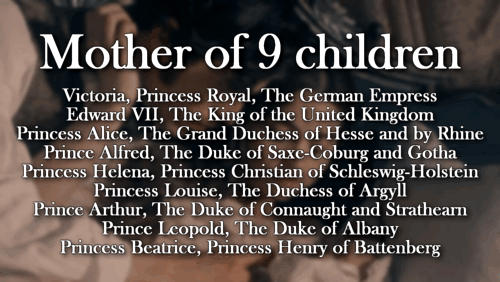
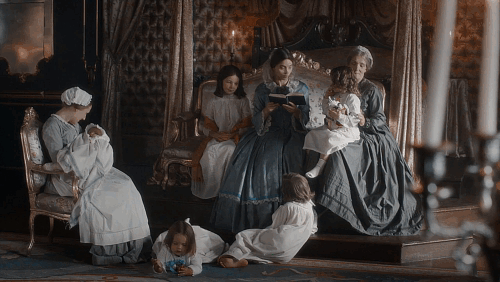
House of Hanover & of Coburg: Princess Alexandrina Victoria of Kent aka Queen Victoria
Queen Victoria was born as the only child of Prince Edward, The Duke of Kent and Starthearn, and his wife Princess Victoria of Saxe-Coburg and Saalfeld, the former Princess of Leiningen. Until her coronation, Victoria was called Princess Alexandrina Victoria of Kent. At the age of 11, she had moved from fifth in line to the throne of Great Britain to being the heir presumptive of her paternal uncle King William IV since his marriage to Princess Adelaide of Saxe-Meiningen had produced no living off-spring.
Many things can and have been said about Victoria. As this blog is dedicated to people who are either German or Austrian or have married in a house from these two nationalities, I want to focus on Victoria’s German connections.
Her mother Victoria had been married before she became The Duchess of Kent to The Prince of Leiningen. With him, she had two children: Carl, The 3rd Prince of Leiningen and Princess Feodora of Leiningen, The Princess of Hohenlohe-Langenburg. Together with Feodora, Victoria was raised by their German governess Baroness Lehzen at Kensington Palace. The sisters remained close to one another. Through this connection, Victoria was not only the mother of a German Empress but great aunt to her successor.
Victoria married her German cousin Prince Albert of Saxe-Coburg and Gotha. Through this marriage, the end of the British Hanoverian dynasty was finally sealed. Her son Albert, who would succeed her as Edward VII, belonged to newly founded British branch of the House of Saxe-Coburg and Gotha, itself a cadet branch of the House of Wettin, that today calls itself the House of Windsor. Victoria’s succession had already ended the personal union with the Kingdom of Hanover, since according to Salic law women where not allowed to succeed.
Since Victoria’s mother had eight siblings, she was not only a first cousin of her husband and his brother but also for example of the first and only Empress of Mexico, King Ferdinand II of Portugal and King Leopold II of Belgium.
Her first great travel abroad led her to her husband’s home of Coburg. Here she is welcomed so fondly that from then on she called the city her second home. According to the official website of the city, she apparently also stated that if she had not been Queen of England, she would have loved to live there. After Albert’s death, she even personally came to Coburg with her children to reveal a statue that had been built in his honor. The last time, she visits Coburg is in 1894 for the marriage of her grandchildren Princess Victoria Melita of Saxe-Coburg and Gotha and Ernest Louis, The Grand Duke of Hesse. During the celebrations, her other granddaughter and Ernest Louis’ sister Princess Alix of Hesse and by Rhine became engaged to the Russian heir to the throne.
Except for Princess Louise, all of Victoria’s daughters married into German houses. While Vicky became German Empress, her younger sister Alice became Grand Duchess of Hesse and by Rhine. Helena and Beatrice would marry minor German princes. Victoria and Albert’s three youngest sons all married German princesses. Only Edward married the Danish princess Alexandra who actually had a German mother.
Through those marriages, Queen Victoria would soon receive the nickname of grandmother of Europe. No wonder when your 40 grandchildren include the German Emperor, the Russian Czar and his wife, the King of the United Kingdom, Queen Sophia of Greece, Queen Maud of Norway, the Grand Duke of Hesse and his wife, the Duke of Saxe-Coburg and Gotha, Queen Marie of Romania, the Duke of Schleswig-Holstein, Crown Princess Margaret of Sweden and Queen Victoria Eugenie of Spain. All these marriages were originally intended to keep the peace in Europe but in the end they could not prevent the First World War.
Queen Victoria died on January 22th, 1901, as the at the time longest reigning British monarch. She would only be surpassed by her great-great-granddaughter Queen Elizabeth II 114 years later.
// Jenna Coleman as Queen Victoria in Victoria
#period drama#perioddramaedit#victoria itv#queen victoria#historyedit#women in history#historic women#german history#british history#House of Coburg#House of Hanover#Women of the House of Hanover#European history#1800s#19th century#princess alexandrina victoria of kent#Queen Consorts of England#<---this hashtag is only used to sort her with the other queens of england#House of Welf#House of Wettin
389 notes
·
View notes
Photo

Princess Adelaide of Saxe-Meiningen
#Adelaide of Saxe-Meiningen#House Saxe-Meiningen#xx century#people#portrait#photo#photography#Black and White
1 note
·
View note
Text


On March 27th, 1819, Princess Charlotte Augusta Louise of Clarence was born in Hanover. Her parents, the future William IV and Princess Adelaide of Saxe-Meiningen, had been married in July of the previous year. The wedding was a result of the race among the unmarried sons of George III to provide an heir to the throne, after the only surviving, legitimate heir, Princess Charlotte of Wales, the daughter of the Prince Regent, died in childbirth along with her son.
Adelaide was only seven months pregnant at the time of Charlotte's birth, and had developed pleurisy during her pregnancy which led to the early delivery. The premature princess lived only a few hours, and was buried there in Hanover.
Her parents would have at least 3 other pregnancies, possibly 4, but ultimately had no surviving children.
#Adelaide of Saxe-Meiningen#charlotte of clarence#william iv#house of hanover#regency era#british royal family
16 notes
·
View notes
Link
On a summer’s day in 1818, a young German princess walked into one of the most famous hotels in London to meet a man twice her age. Just a year earlier, Adelaide of Saxe-Meiningen and her suitor, William, Duke of Clarence, would never have considered chatting let alone taking the step that would inevitably follow this brief exchange.
0 notes
Photo
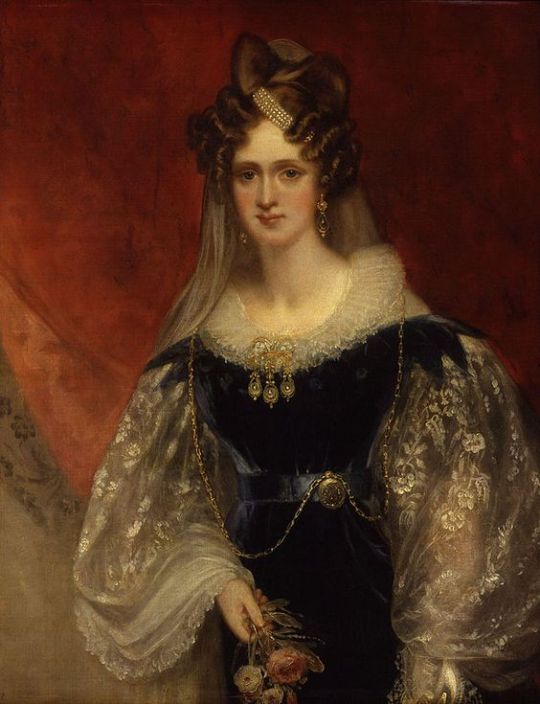
Those that have married in to Royal Families since 1800.
UK Edition
Adelaide of Saxe-Meiningen Queen Consort of the United Kingdom and Hanover as spouse of William IV.
Adelaide married William in a double wedding with William’s brother, Prince Edward, Duke of Kent, and his bride Victoria, Dowager Princess of Leiningen, on 11 July 1818, at Kew Palace in Surrey, England. They had only met for the first time about a week earlier and William was twenty-seven years her senior.
Despite these unromantic circumstances by all accounts were devoted to each other throughout their marriage. Adelaide improved William’s behaviour; he drank less, swore less and became more tactful.
Adelaide, the capital city of South Australia is named in honour of her her at its founding in 1836; the Queen Adelaide Club for women is still active, and a bronze statue of Queen Adelaide stands in the foyer of the Town Hall.
2 notes
·
View notes